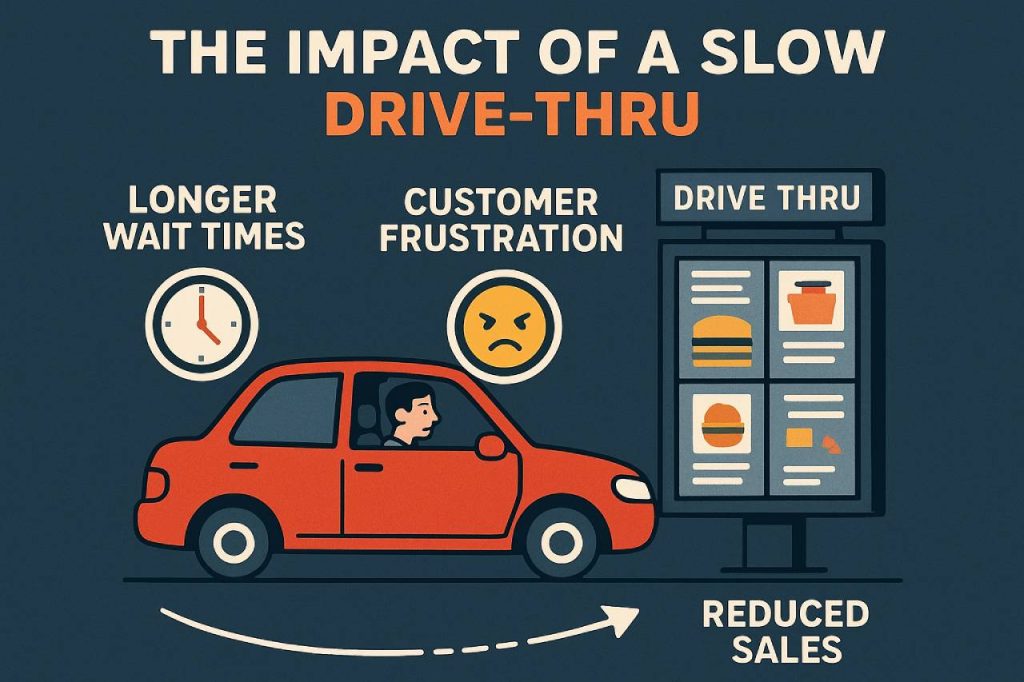Speed, efficiency and accuracy are the names of everyone’s drive-thru game at Quick Service Restaurants. Failing to deliver on these can prove catastrophic to your business. Having a drive-thru operation alone, you imply that you offer convenience for your customers. And while accuracy is important, nothing will frustrate customers more than longer than expected waiting times. The adverse effect of this will be felt in your profits, loyalty and reputation, or lack thereof.

Let’s Do the Math!
Studies suggest that the average drive-thru customer has an expectation and tolerance to wait 5-6 minutes from the time they place their order to the time they are pulling away with their food. As time exceeds that threshold, increased cars filter into the line, frustration begins to form, and emotions can unravel quickly. It is human nature to navigate past potential frustration points on a day-to-day basis. When applying this to the drive-thru lane, it becomes less likely for someone to return if they are discouraged by the time it takes. Now take that single person and multiply it by, say, 10 each hour. Then stretch that out over the course of a week or month. The dollars of losses can quickly reach thousands.
More perspective… if you serve 100 cars in the morning rush and ten of them are dissatisfied with your wait time the multiplier of that over the course of time can be crushing. You make yourself vulnerable to poor word of mouth, negative reviews and the aforementioned financial impact of the non-return customer.
In fact, industry studies have found that even shaving 20 seconds off average service time can boost sales by as much as 2–3% annually. That’s a huge return for what might seem like a small operational improvement.
Whether you consider your drive-thru lane to be fast or slow, by snipping an additional 15-20 seconds on your service time can increase sales by 2-3 % over the course of the year based on a QSR Magazine study. That is 2-3% on your annual return which depending on your volume can be a substantial amount of money.
What is Slowing You Down?
There are several factors that could be playing in to the poor speed of your drive-thru lane. For example:
- Lack of order accuracy. People check their bags and if it isn’t correct, you might be waiting there for a while
- Poorly positioned drive-thru menu board. If mounted too close to the window (not enough room to stack cars) or too far (to many “open orders” in the queue), orders can take longer to receive or get out
- Unclear communication systems and other technology issues. If you struggle to hear the employee or vice versa and things must get repeated, it is naturally going to slow down the lane. Couple that with a lagging POS system that takes some time to display the orders out at the drive-thru and on the internal POS screen and it becomes a recipe for a slow output.
- Confusing menu designs. When done well, customers should be able to find the section and the menu items in which they are interested within seconds. When the opposite is the case, it can be incredibly detrimental to the business and annoying to your customers.
- Employee preparedness. Plain and simple, if an employee isn’t properly trained, it’ll take them longer to articulate the upsells, enter orders, process the orders tweaks, etc. It just slows things down.
Now that we have identified these areas, let’s look at how to remedy them.
How to Fix It
Consult a Professional: Company’s like Origin Displays will work with you to identify products that will work within your budget while maximizing their effectiveness. In addition, they can look at site drawings or do surveys to offer consultation on the placement of your products.
Spend on Technology: New high-definition drive-thru headset systems make order-taking seamless and increase accuracy. Keying these orders into POS systems set up for a drive-thru operation further streamlines the process. AI will continue to add value to the speed of transactions as well.
Keep it Simple: An afterthought at times, the layout of your drive-thru menu designs can have a serious impact on your throughput. Cluttered and disjointed layouts confuse and overwhelm your customers and can cause a bottleneck at the drive-thru. You should highlight your high-ticket items and use pictures to identify the different sections of your menu.
Spend Time on Training: Handing a headset to a new employee and saying, “good luck” would not be considered a “best practice.” Investing the time in training will result in an employee with greater confidence and know-how handling the various requests thrown at them and provide a greater ability to weather the daily rushes.
Use Metrics: A byproduct of “investing in technology” is analyzing the data available to you. Drive-thru timers can identify bottlenecks and operational efficiencies that can be worked on. Conversely, you can set benchmarks where if your employees hit certain goals, you can reward them.
Summary
When opening a drive-thru, costs can quickly surge. There is no denying that it is a “leap of faith” to set up your lane the “right way” from the get-go. However, if you don’t you leave yourself susceptible to less than ideal results. If you take anything away from this blog, it should be to consult a professional in the field. Most will give you a reasonable amount of time to help direct you to solutions that will meet your needs.
Do you need help making these determinations for your business? Give us a call today at 888-235-2579, email us at info@origindisplays.com or contact us here to speak with a solutions specialist.